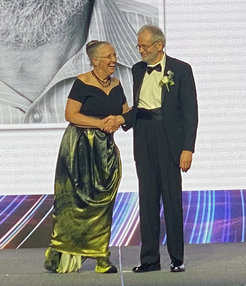Inge Lehmann Medal for Prof. Dr. Ulrich Christensen
Ulrich Christensen, Director at the Max Planck Institute for Solar System Research, receives one of the highest awards of the American Geophysical Union.
The American Geophysical Union (AGU) yesterday awarded the Inge Lehmann Medal to Prof. Dr. Ulrich R. Christensen, Director at the Max Planck Institute for Solar System Research (MPS). With this award, the AGU acknowledges Prof. Dr. Christensen’s outstanding contributions to the understanding of the dynamic processes in the Earth's mantle and core. His work has contributed decisively to a detailed and realistic picture of the processes in the Earth's core that generate the Earth's magnetic field. In addition, he was also able to transfer many of his findings and methods to other planets, moons, and distant stars ? and thus gain new insights into the magnetic fields of these bodies.

Deep below us, the Earth’s interior is in motion. In the Earth's mantle, for example, which extends 660 to 2900 kilometers below the surface, temperatures and pressures are so high that the rock becomes deformable. Driven by temperature differences between the inner and outer boundaries of the mantle, over millions of years the rock creeps from the interior to the crust ? and vice versa.
At the beginning of his scientific career, these sedate currents, which are responsible, among other things, for the movements of the tectonic plates, were Christensen’s main research interest. As in his later career, he relied on numerical calculations to simulate the exact processes and thus better understand them. For example, he developed a comprehensive theory connecting the currents in the Earth's mantle with the distribution of isotopes, i.e. atoms of the same type but of different weight, in the magmas that rise from the Earth's mantle to the surface.
In the mid-1990s, Christensen’s attention shifted further inwards to Earth’s outer core located at a depth of 2900 to 5100 kilometers ? and with it to the magnetic properties of our planet. Like the Earth's mantle, the outer core is the scene of enormous material upheavals. However, iron and nickel, the main components of this region, are liquid and electrically conductive under the temperatures and pressures prevailing there. The iron-nickel melt flows much faster than the Earth's mantle; in addition, the Earth’s rotation causes swirls and vortices. This creates magnetic fields. In a kind of dynamo process, they amplify themselves and thus generate the Earth's magnetic field, which extends far into space and protects our planet from charged particles from the Sun.
In an attempt to simulate these processes on the computer, researchers inevitably encounter a problem: the low viscosity of the iron-nickel melt produces extremely small-scale flows that can hardly be simulated on the computer with today's computing power. Can certain properties of the overall system be "artificially" altered for computer calculations in such a way that the basic physical processes are retained while the computing effort is reduced to a manageable level? This is one of the questions Christensen has investigated. He comprehensively studied which fundamental properties of the Earth's core influence its currents ? and with them the magnetic field.

Considerations of this kind made it possible for Christensen to transfer the dynamo theory of Earth to other planets and moons. Mercury, the gas giants Jupiter and Saturn, as well as some of their moons are also enveloped in a magnetic field. However, their strengths are very different; Jupiter’s surface magnetic field, for example, is a thousand times stronger than that of Mercury. What is the reason for this? Which properties, be it the size of the core, rotational speed or electrical conductivity, are decisive? In a groundbreaking study, Christensen was able to identify the energy flow in the liquid core as the decisive factor. Bodies that within their core transport a comparable amount of energy to the outside per time unit thus exhibit similar magnetic fields. In recent years, Christensen has focused his attention in part even further away from Earth ? on stars and their magnetic properties.
After studying physics and obtaining his doctorate at the Technical University of Braunschweig (Germany), Prof. Dr. Ulrich Christensen habilitated in 1985 at the University of Mainz in the field of geophysics. After research stays in Mainz (Germany), Arizona (USA), and Utrecht (Netherlands), Christensen was appointed Professor of Geophysics at the Georg-August-Universität Göttingen in 1992. Since 2002 he has been Director at the Max Planck Institute for Solar System Research, where he heads the department "Planets and Comets". His many awards include the Leibniz Prize, the highest scientific award in Germany, and the August Love Medal of the European Geosciences Association. Christensen is the author of more than 140 scientific publications cited more than 10,000 times.
The American Geophysical Union is the world's largest geophysical science organization with more than 60,000 members, 40 percent of whom are based outside the United States. The Inge Lehmann Medal, awarded every one to two years since 1997, recognizes an outstanding researcher who has made decisive contributions to understanding the structure, dynamics, and composition of the Earth's mantle and core. The award is named after the Danish seismologist and geophysicist Inge Lehmann, who discovered in 1936 that the Earth's core is not completely liquid, but consists of solid iron in the center.













